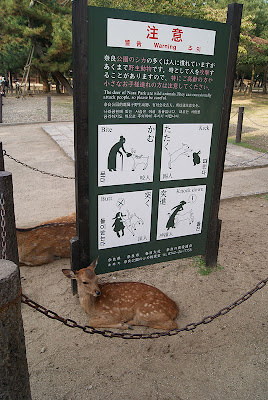 |
| A heard of deer carelessly walking through a crowd of people in a Nara park. |
Nara is a beautiful city full of history and wonders that is often overlooked in favor of the larger and more famous neighboring cities of Osaka and Kyoto.
However taking a day or two to visit Nara is well worth the trip for anyone who can make it. It is less than an hour away from both Kyoto and Osaka and is a very simple trip by train.
Nara is a beautiful city populated many Buddhist Temples and maybe even more notably, deer (but we’ll get to the deer in a little bit).
If for nothing else it is worth a visit just to say you have gone to the first capital of Japan; as Nara was the original permanent capital of Japan and remained so for most of the eighth century.
 |
| A few deer wandering right off the main road in Nara. |
The first thing one is likely to notice in Nara is the deer. There are deer absolutely everywhere. They comingle with the people on the streets, harass tourists trying to purchase omiyagis, and lounge about on the paths and lawns outside the temples. Every fifty feet there are venders selling food to feed the deer (and often beer to make this an even more interesting experience). People come from all over to feed and pet these deer, parents make their terrified children pose for pictures, in fact the deer themselves might be the biggest draw the city has. There are even ceremonies celebrating the deer like the antler cutting ceremony I witnessed during my visit.

Despite the constant “Kawaii”s one may hear while socializing with these creatures, there are signs scattered about the city warning of the dangers the deer pose. The deer put up with the tourists for one reason; they want to be fed. And if one has an empty stomach, humans beware. The deer will chase, head-butt, and even bite visitors in their quest for food, and when this happens these cute cuddly creatures turn into terrifying beasts. I noticed this myself in my multiple trips to Nara and the different attitudes these creatures take on depending on the day. When the weather is nice and the there are plenty of tourists to feed the deer they lazily wander about on a full stomach only venturing towards the people when they feel they can stomach one more biscuit. But on rainy days when people are scarce these deer might as well be monsters. I was chased by a pack of deer and repeatedly head-butted for about 200 meters before climbing to safety on a statue. In times like this, these deer are more of a threat than a tourist attraction.
 |
| Pay no attention to that cute little fawn, as the sign says, the deer will maul you. |
 |
| Todaiji Temple |
Apart from the terrible wonder of the deer, another great thing to see in Nara is Todaiji Temple. It is one of the largest wooden buildings in the world and is as beautiful as it is large. It traditional architecture in combination with a wondrous lawn makes for a stunning scene. Inside, this temple houses an enormous Buddha and two giant guardian statues, some of the more impressive pieces of historical Buddhist art you will find in Japan. And for those daring enough one of the support beams inside has a hole the size of a guardian’s nostril, and crawling through it is said to give you good luck. This is a place that is more than worth the small train fair and time it takes to get there is would be enjoyable to people of all ages and nationalities.
 |
With a little bit of struggle I got through the hole in the support beam.
|
 |
One of the Guardians of the temple.
|











